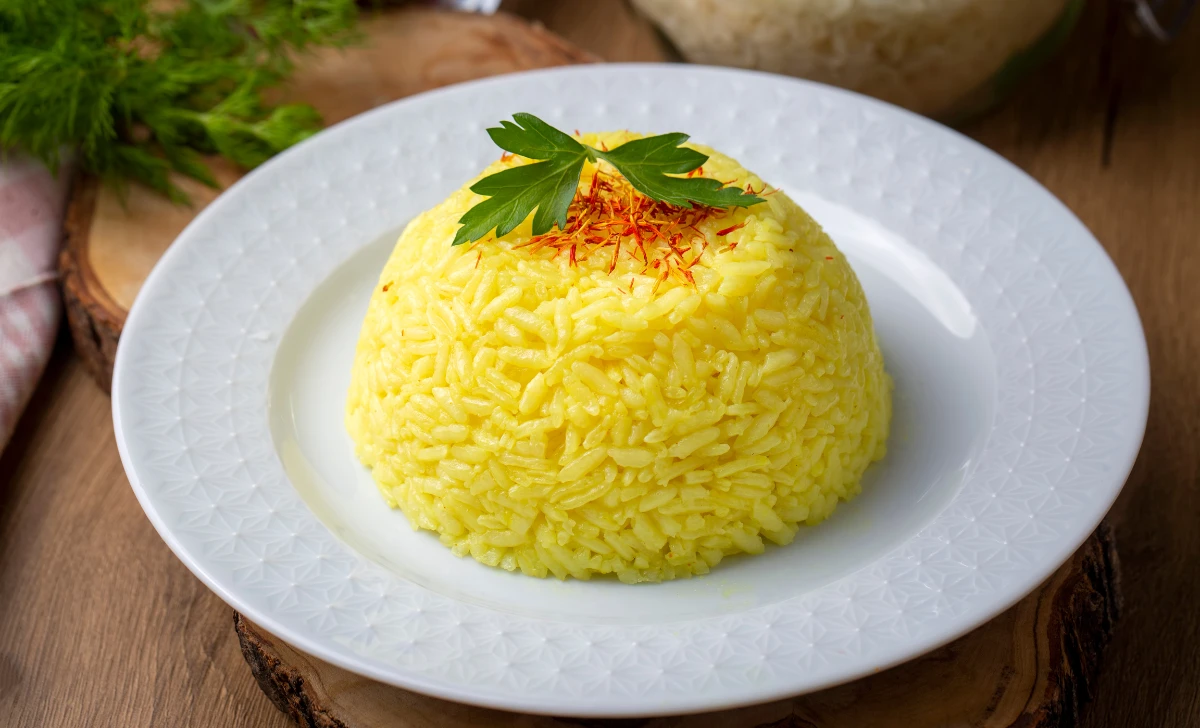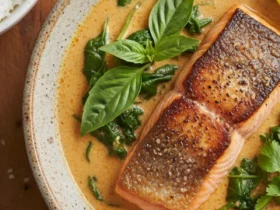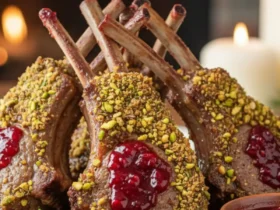Are you ready to embark on a culinary adventure that tantalizes your taste buds and fills your kitchen with the delightful aroma of saffron? Look no further than this Safranli Pilav recipe! In this guide, we’ll walk you through the steps to create a sumptuous saffron-infused rice dish that will elevate any meal to a whole new level. Whether you’re a seasoned chef or a kitchen novice, this recipe is designed to be simple, enjoyable, and incredibly rewarding.
[ez-toc]
History
The Safranli Pilav recipe we enjoy today is a culinary gem that has been crafted and perfected over centuries, weaving together flavors, techniques, and cultural influences from various corners of the world. This fragrant saffron-infused rice dish carries a history as vibrant and captivating as its golden hue. Let’s embark on a journey through time to unravel the fascinating origins and evolution of Safranli Pilav.
Ancient Roots and Culinary Crossroads
The roots of Safranli Pilav trace back to the crossroads of civilizations that flourished along the ancient Silk Road. This intricate network of trade routes connected the East to the West, fostering the exchange of spices, ingredients, and culinary traditions. Saffron, the star ingredient of our beloved pilav, holds a special place in this narrative.
Saffron’s origins can be found in the regions of ancient Persia (modern-day Iran) and Greece, where it was cherished for its vivid color, delicate fragrance, and unique flavor. It was during these early days that saffron began its journey as a highly prized and sought-after spice, known for its use in both culinary and medicinal applications.
Turkish Delights: Safranli Pilav Takes the Stage
Fast forward to the heart of Turkish cuisine, and we find Safranli Pilav emerging as a treasured dish that marries saffron’s allure with the art of rice preparation. The Ottoman Empire, renowned for its culinary sophistication, played a pivotal role in elevating pilav to a new level of culinary excellence.
The Ottoman kitchen, a melting pot of culinary traditions, absorbed and incorporated diverse influences from the regions it encompassed. Saffron, with its luxurious appeal, became a natural addition to the Ottoman culinary repertoire. As saffron’s reputation grew, so did its presence in the kitchens of palaces and homes alike.
From Palaces to Palates: Safranli Pilav’s Culinary Voyage
Safranli Pilav’s journey from palace kitchens to everyday dining tables marked a transition that celebrated both opulence and accessibility. What was once an indulgence of the elite became a beloved dish that could be enjoyed by a wider range of people.
Through generations, Safranli Pilav recipes were refined and adapted, reflecting regional nuances and family traditions. As Turkish cuisine continued to evolve, the pilav retained its timeless allure, offering a harmonious blend of flavors and textures that transcended time and boundaries.
Global Influence and Contemporary Delights
In the modern culinary landscape, Safranli Pilav has embraced its global appeal. With the ease of international travel and the widespread availability of ingredients, this dish has traveled far beyond Turkey’s borders. Food enthusiasts and curious cooks around the world have embraced the magic of saffron and the comforting embrace of perfectly cooked rice.
Chefs and home cooks alike have experimented with variations of Safranli Pilav, adding their unique twists and interpretations. Whether served as a side dish or the star of the show, the pilav continues to captivate palates and inspire creativity in kitchens everywhere.
Preserving Tradition and Savoring Memories
As we savor each forkful of Safranli Pilav, we become part of a culinary tradition that spans centuries. Every bite carries the echoes of ancient spice routes, the opulence of royal feasts, and the warmth of family gatherings. Safranli Pilav isn’t just a dish; it’s a vessel that transports us through time, allowing us to connect with the rich tapestry of human history and culture.
So, the next time you prepare Safranli Pilav, take a moment to appreciate the layers of history that have contributed to this delightful creation. With every fragrant aroma and savory taste, you’re celebrating a legacy that has been passed down through generations – a legacy that continues to bring joy, comfort, and a touch of magic to our plates and hearts.
Time
| Step | Time |
|---|---|
| Gathering Ingredients | 10 minutes |
| Preparing Saffron Infusion | 5 minutes |
| Warming Chicken/Vegetable Broth | 5 minutes |
| Sautéing Onions and Butter | 7 minutes |
| Coating Rice with Butter | 3 minutes |
| Adding Saffron Infusion to Rice | 2 minutes |
| Simmering Rice and Broth | 15 minutes |
| Fluffing and Separating Rice Grains | 5 minutes |
| Total Cooking and Preparation Time | Approximately 52 minutes |
Note: Cooking times are approximate and may vary based on individual cooking methods and equipment.
Ingredients
| Quantity | Ingredients |
|---|---|
| 1 cup | Long-grain white rice |
| 2 cups | Chicken or vegetable broth |
| A pinch | Saffron threads |
| 1 medium-sized | Onion, finely chopped |
| 3 tablespoons | Butter |
| To taste | Salt |
Note: Ingredient quantities are based on a serving size of 2 people. Adjust quantities accordingly for larger servings.
Directions
Step 1: Gather the Essentials
Before you dive into the delightful journey of crafting Safranli Pilav, ensure you have all the necessary ingredients and tools at your fingertips. Having everything ready will make the cooking process smooth and enjoyable.
Step 2: Preparing the Saffron Infusion
- Place a pinch of saffron threads in a small bowl.
- Add a tablespoon of hot water to the saffron threads, allowing them to bloom and release their captivating aroma and vibrant color. Set aside.
Step 3: Warming the Chicken/Vegetable Broth
- In a separate pot, gently warm the chicken or vegetable broth over low heat. This will ensure that the broth is ready to infuse the rice with its rich flavor.
Step 4: Sautéing Onions and Butter
- In a deep pan, melt the butter over medium heat.
- Add the finely chopped onion and sauté until it turns a glorious shade of gold. Allow the sweet and savory notes of the onion to fill the air.
Step 5: Coating Rice with Butter
- Stir in the long-grain white rice, ensuring that each grain is coated with the luscious, fragrant butter. This step is essential for achieving the perfect fluffy texture in the final pilav.
Step 6: Adding Saffron Infusion to Rice
- Gently pour the saffron infusion over the rice, creating a beautiful dance of color and flavor. Watch as the saffron’s essence is absorbed by the rice, transforming it into a golden masterpiece.
Step 7: Simmering Rice and Broth
- Carefully pour the warm chicken or vegetable broth into the pan, allowing the rice to luxuriate in the flavorful bath.
- Bring the mixture to a gentle simmer, then cover the pan. Let the rice absorb the broth and saffron-infused goodness over low heat.
Step 8: Fluffing and Separating Rice Grains
- Once the rice has absorbed the broth and the grains are tender, uncover the pan.
- Gently fluff the rice with a fork, separating the grains and allowing any remaining liquid to evaporate. Each forkful should carry the essence of saffron and the perfect texture.
Step 9: Serve and Enjoy
- Your Safranli Pilav is now ready to be enjoyed! Serve it as a delightful side dish or pair it with your favorite main course.
- Savor each bite of the saffron-infused rice, and let the flavors transport you to a world of culinary bliss.
Note: Cooking times may vary based on individual stovetop settings. Adjust accordingly to achieve the desired texture and flavor.
Equipment Required
Nutrition Information
| Nutrient | Per Serving |
|---|---|
| Serving Size | 1 cup (approx. 200g) |
| Calories | 250 |
| Total Fat | 8g |
| – Saturated Fat | 5g |
| Cholesterol | 20mg |
| Sodium | 500mg |
| Total Carbohydrates | 40g |
| – Dietary Fiber | 1g |
| – Sugars | 1g |
| Protein | 4g |
Note: Nutrition values are approximate and can vary based on ingredient brands and portion sizes. Adjustments may be needed for specific dietary requirements.
Tips
- Handle Saffron with Care: Saffron is delicate and potent. Ensure your saffron threads are genuine and of high quality. Store them in an airtight container away from light and moisture to maintain their flavor and color.
- Rice Selection Matters: Opt for long-grain white rice to achieve the signature fluffy texture of Safranli Pilav. The slender grains absorb the saffron and broth beautifully, creating a harmonious blend of flavors.
- Blooming Saffron: When preparing the saffron infusion, use hot water to awaken the threads’ flavor and color. Allow the saffron to bloom for a few minutes to maximize its impact.
- Broth Choice: Choose chicken or vegetable broth based on your preference. Each lends its unique flavor to the pilav, enhancing its overall taste.
- Low and Slow: Keep the heat low and gentle when simmering the rice. This slow cooking method ensures the rice fully absorbs the saffron and broth, resulting in a lusciously flavorful dish.
Pros & Cons
| Pros | Cons |
|---|---|
| ✅ Rich saffron flavor | ❌ Requires careful handling of saffron |
| ✅ Elegant golden hue | ❌ Saffron can be expensive |
| ✅ Versatile side dish | ❌ Longer cooking time compared to plain rice |
| ✅ Aromatic and flavorful | ❌ May not be suitable for saffron skeptics |
| ✅ Impressive presentation | ❌ Sensitive to heat, may overcook if not careful |
Conclusion
As we bring our culinary journey to a close, we invite you to embark on an adventure that transcends the boundaries of flavor and tradition – the enchanting world of Safranli Pilav. This saffron-infused masterpiece is more than just a dish; it’s a symphony of colors, aromas, and tastes that dance on your palate.
With every forkful of fluffy rice, delicate saffron threads, and buttery goodness, you’ll be transported to a realm of culinary delight that spans centuries and continents. The luscious, golden hue and captivating aroma are a testament to the artistry that is woven into each grain.
Whether you’re seeking a sumptuous side dish, a canvas for your culinary creativity, or simply a taste of history, Safranli Pilav offers a world of possibilities. Its elegance and versatility make it a cherished companion for both everyday meals and special occasions, effortlessly elevating any feast it graces.
So, why not don your apron, gather the essential ingredients, and embark on a journey that will awaken your senses and delight your taste buds? Safranli Pilav beckons, ready to unveil its magic in your very own kitchen. Embrace the saffron’s allure, savor the delicate flavors, and create a memory that lingers long after the last grain is enjoyed.
Dive into the world of Safranli Pilav – where history, tradition, and culinary artistry converge to create a sensory masterpiece that’s yours to savor, share, and celebrate. Bon appétit! 🍚🌟
Facts
- Fact 1: Saffron, the “Sunrise Spice” 🌅
- Did you know that saffron, the star of Safranli Pilav, is often referred to as the “sunrise spice”? Just like the early morning sun paints the sky with hues of gold and orange, saffron’s vibrant threads infuse the pilav with its dazzling color and unique flavor.
- Fact 2: A Royal Connection 👑
- Safranli Pilav has a regal history! Legend has it that the Ottoman Sultans were enamored with saffron’s luxurious appeal and included it in their lavish feasts. Each saffron-infused grain in the pilav carries a whisper of the palace kitchens’ opulence.
- Fact 3: Saffron’s Secret Symbolism 🌟
- In many cultures, saffron is more than a spice; it’s a symbol of prosperity and joy. In ancient Persia, saffron was used to dye the robes of royalty and in Hindu rituals, it was considered an auspicious offering. With Safranli Pilav, you’re not just cooking; you’re weaving stories of tradition and happiness.
- Fact 4: The Saffron Heist 🕵️♂️
- Saffron’s value has led to some daring tales! In history, saffron was so precious that it became the target of thieves and smugglers. Imagine a culinary caper where saffron threads were whisked away like precious gems – adding a sprinkle of mystery to your pilav preparation.
- Fact 5: Culinary Artistry Meets Science 🔬
- Creating the perfect Safranli Pilav is a blend of art and science. Saffron’s chemical compounds react with the rice’s starches to create its mesmerizing color and flavor. It’s like a culinary chemistry experiment that results in a plate of pure delight – a feast for both the senses and the curious mind!
FAQ’s
Is saffron expensive?
Yes, saffron is considered one of the most expensive spices due to its labor-intensive harvesting process. However, a small amount goes a long way, making it a worthy investment for its unique flavor and vibrant color.
Can I use brown rice for this recipe?
While Safranli Pilav is traditionally made with long-grain white rice, you can experiment with brown rice for a nuttier flavor and added nutritional benefits. Adjust the cooking time and liquid accordingly.
How do I store leftover saffron pilav?
Store any leftovers in an airtight container in the refrigerator. To reheat, add a splash of broth or water and gently steam on the stovetop.
Can I add vegetables or protein to the pilav?
Absolutely! Safranli Pilav serves as an excellent base for various additions. Consider incorporating peas, carrots, cooked chicken, or even toasted nuts for extra texture and flavor.
What’s the origin of saffron in cooking?
Saffron’s use in cooking dates back centuries, with historical roots in Mediterranean, Indian, and Middle Eastern cuisines. Its unique taste and vibrant color have made it a prized ingredient in dishes across the globe.
Can I use vegetable broth instead of chicken broth?
Yes, you can certainly use vegetable broth as a flavorful alternative to chicken broth. It will add a wonderful depth of taste to the pilav.
How can I prevent the rice from sticking to the pan during cooking?
To prevent rice from sticking, make sure to stir it gently when sautéing and ensure the heat isn’t too high. Also, using a non-stick pan or adding a bit more butter can help.
Can I make Safranli Pilav in a rice cooker?
While the traditional method involves stovetop cooking, you can adapt the recipe for a rice cooker. Follow the same steps until adding saffron and broth, then transfer to the rice cooker and continue according to its instructions.
Can I use saffron powder instead of saffron threads?
Saffron threads are recommended for the best flavor and color, but if using saffron powder, reduce the quantity and add it directly to the rice before adding broth to avoid clumping.
What should I serve with Safranli Pilav?
Safranli Pilav is a versatile side dish that pairs well with a variety of mains, such as grilled meats, roasted vegetables, or even a simple salad. It complements a wide range of flavors, making it a delightful addition to any meal.












Leave a Review